#medieval sewing
Explore tagged Tumblr posts
Text

Late 15th Century Nun
I have teased this for a while, that I am planning to make a medieval nun habit, and well... here we are! I have started! (edit: here is a disclaimer in case you have any strong feelings regarding this project)
I have done a lot of research, and am still doing more, as I want this to be nice and as accurate as possible. Nun habits are different from order to order and from region to region. And of course depends on the nuns rank. Currently I am trying to base mine of German nuns, as I have most sources for that, but ideally I would like to portray a nun specifically from the 'Nonneseter kloster i Oslo', as I live and do reenactment mostly in Skandinavia and for this cloister we have some sources on! A big source is also this book:

which is amazing! If you can read German and are interested in medieval nuns, I can 100% recommend it, it is well written, well researched and gives such amazing insights into the life of nuns it is great.
The habits are either white, grey, brown or black, and consist of a base dress, sometimes a scapular, sometimes an overdress or a cloak. And of course veils in different styles, in some regions also a nun crown.
I am still researching but currently my plan is a white base dress, and then build onto it by also making a black scapular, a black overcoat and a black veil (on top of the white). I already got a thin nice white wool for the veil!
And I also recently bought a few meters of a nice, thin, white wool for the base dress
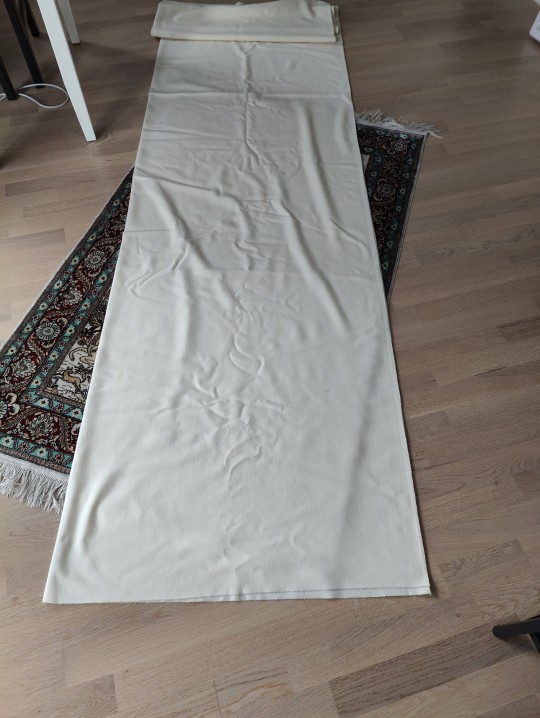
it is very nice and soft.
I reused the pattern of my 15th century gown for the top part, as I know it fits and has the shape I'm going for, and also the sleeves are fitted. The habits have usually quite wide sleeves so I made them wide too
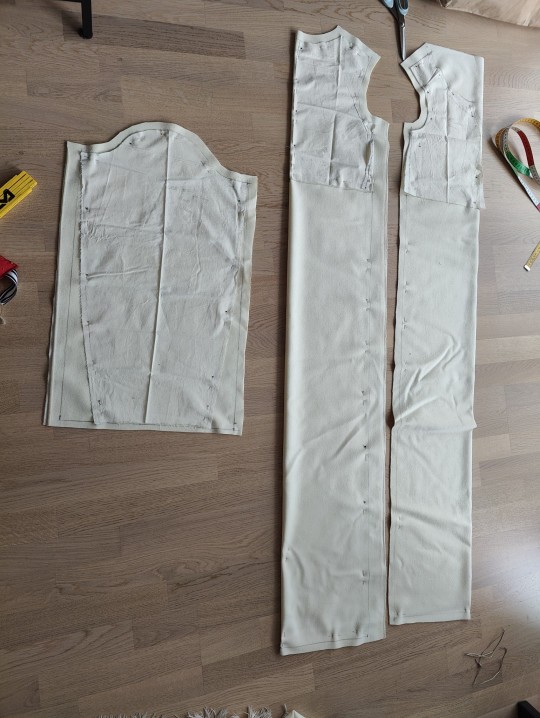
these are the cut pieces. You see that both the front and back are just straight, this is because they will get gores. One in the front, one on the back, and then some in the side seams. As of my plan now, they will start in the waist, so the skirt part will be full, while the top remains as it is now, which is loose, but fitted.
I then proceeded to sew the shoulders, sode seams until the waist, and the sleeves
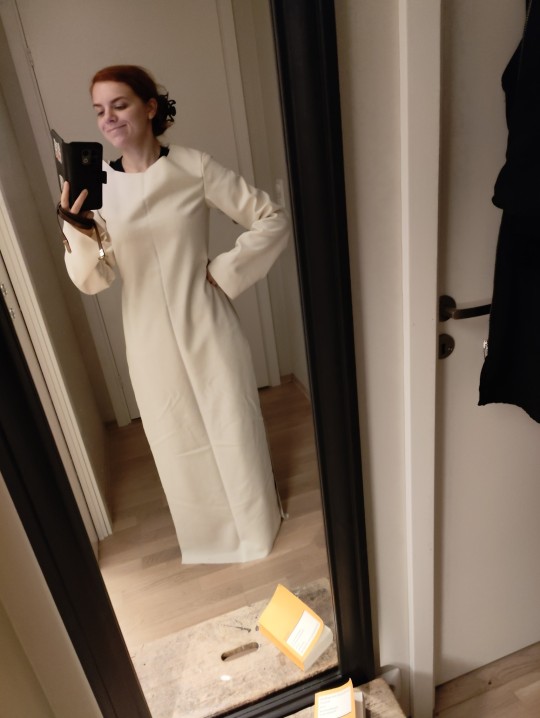

it looks a bit boring, but hey that is nuns for you! Dont mind the stretching, I was wearing a shirt underneath and that messed the fit up a bit.
Next step now is to see how large the gores have to be, to cut them out and sew them in.
I am going to prepare that step, but not sew it yet, as I prepared it for a medieval weekend I am going to in July. So soon I will sit in Sweden at a castle with good friends and show some medieval sewing to tourists, huzzah!
I have not been sewing for a few months due to stress, so it is nice to be back and have a project. also buying all that black wool will bankrupt me I already see it!
Also, here are a few more medieval nuns for you!




#personal#15th century#15th century project#medieval#medievalcore#medieval reenactment#medieval sewing#sewing adventures#myface
96 notes
·
View notes
Text





Just sharing the outfit I wore to renfair a few months ago
#sewing#my sewing#sewing project#vintage fashion#fashion design#handmade#medieval sewing#renfaire outfit#renaissance festival#renfaire#medieval costume#historical costume#costume#historical costuming#honestly i give it a 6/10#i like it but it could have been better#i was short on time#im already working on next years outfit and its going to be amazing#updates coming soon
24 notes
·
View notes
Text
I found this very informative website about mainly medieval sewing and clothing! I've been reading it for a bit now and it's really interesting. I don't know if this is a well known website or not, but I hope others might find it interesting :)
https://rosaliegilbert.com/sitemap.html
2 notes
·
View notes
Note
Hey you have every right to kill me for asking this, but what is it about hose that makes them so difficult to get right? Like I’m genuinely interested in this akjdjs
To make a long story short, you’re basically trying to make skintight socks with non stretch fabric. Due to the way a leg Works, this means they then have to be veeeery carefully tailored so that they have the least amount of wrinkles possible, and also so that you can still get them on and off. The ankle is the trickiest area for this.
To help with this, you cut the fabric on the bias (diagonal) so that it has a liiiittle bit of stretch. Due to this, The Perfect Fit ™ is technically achievable, it just takes (for me at least) hours of patterning, and also occasionally sewing the damn thing while it’s still on my leg xD
The good news is, now that I have the pattern, any future hose will be vastly easier to make, as any tailoring will just be the final tweaks as I get everything in the right spot!
#btw I love when people are interested in my hobby like I’ll almost always answer questions to the best of my ability :D#ask#medieval hose#medieval sewing#*says ‘to make a long story short’ and then types three paragraphs*
25 notes
·
View notes
Text
Medieval Cirilla Dress
Day One
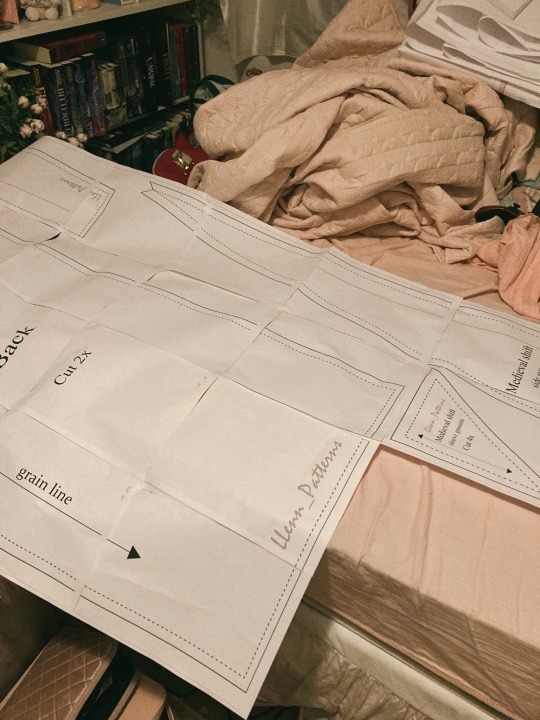
I laid out my print out pattern and taped it together on my bed. Back pain level at 7/10.
Day Two
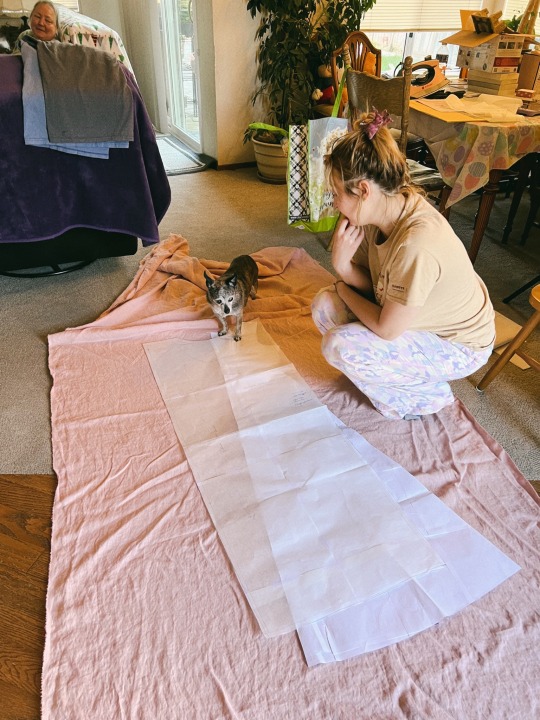
I laid out everything to measure and revise my pattern.
Day Three
I forgot to take a picture of my tracing step. I didn't have a colored chalk; all there was, was pink chalk for a pink fabric. I ended up using a water soluble pencil, which was really just a blue crayon.

I steam ironed for the first time. I realized I've never actually smelled fresh linen before, but I can see why it would be a popular candle scent.

I sat down in the evening to read up on historical hand sewing techniques. I have Bernadette Banner's book, Make, Sew and Mend: Traditional Techniques to Sustainably Maintain and Refashion Your Clothes.
#personal#blog#medieval dress#cirilla costume#cirilla medieval dress#the witcher#the witcher netflix#the witcher costume#medieval costume#historical costuming#medieval sewing#hand sewing#sewing progress#fantasy costumes#bernadette banner#sewing reference#diary post
14 notes
·
View notes
Text
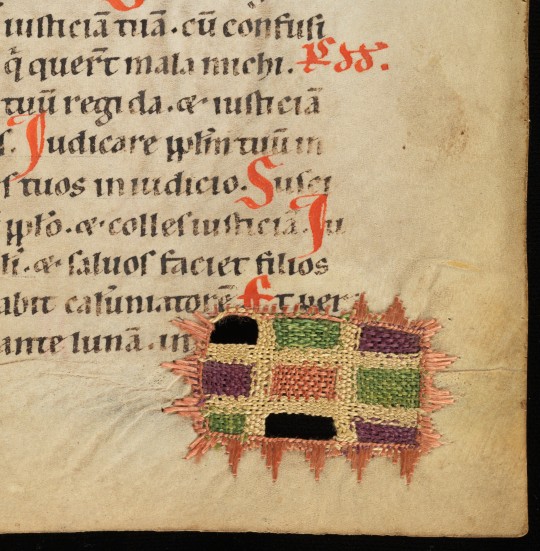
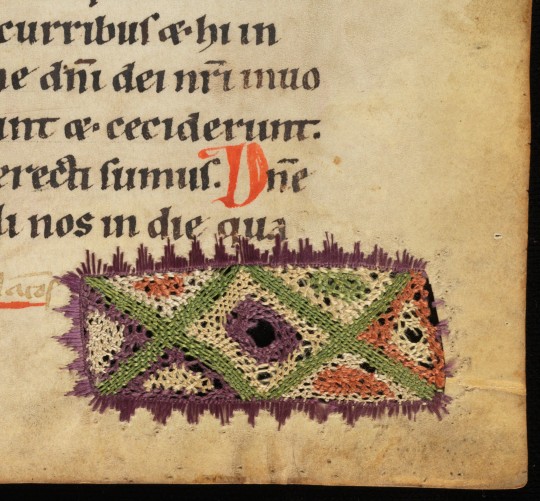
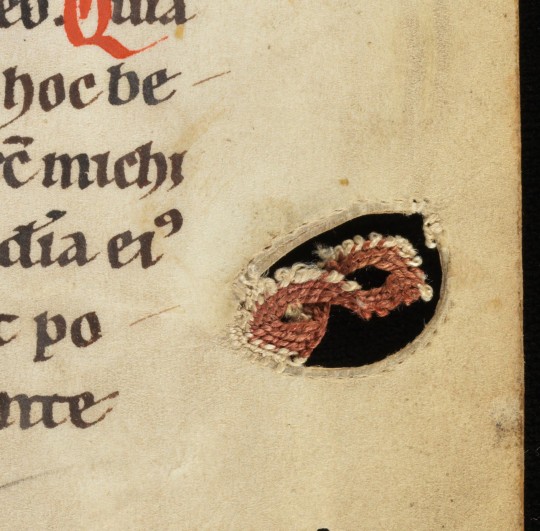
medieval parchment repairs
in a psalter, south-western germany, late 12th/early 13th c.
source: Hermetschwil, Benediktinerinnenkloster, Cod. membr. 37, fol. 19r, 53r, and 110r
#12th century#13th century#repairs#mending#medieval manuscript repairs#sewing#book history#medieval studies#medieval art#psalter#parchment stitching
8K notes
·
View notes
Text
Sewing a turn of the 15th century French kirtle in doll scale
Another day, another historical doll outfit! This time it's Late Medieval. This was a popular style from about 1380-1420 France and Alpine area, but I specifically based this dress on French illuminations from the early 15th century, which mostly effects the details, like headwear. As always I hand stitched everything and stuck to historical construction methods as much as I could.
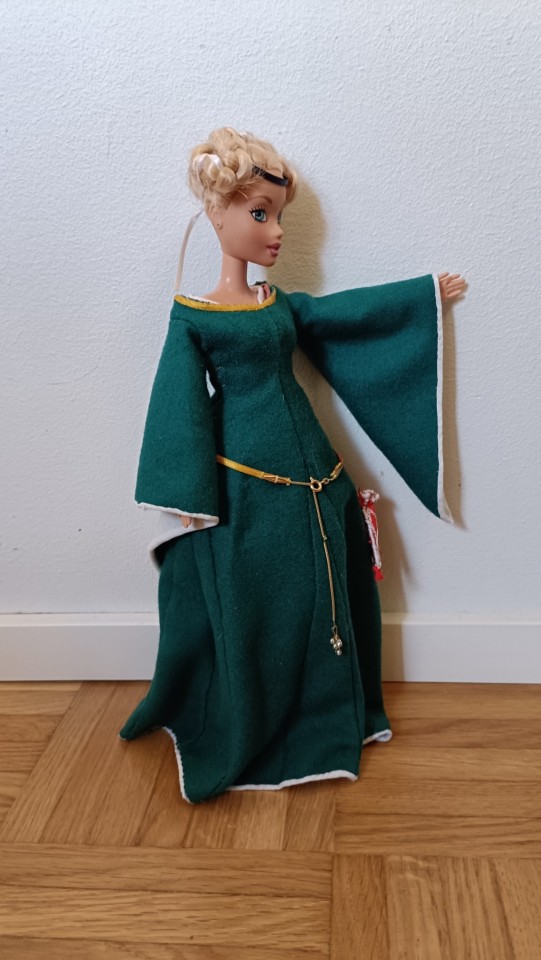
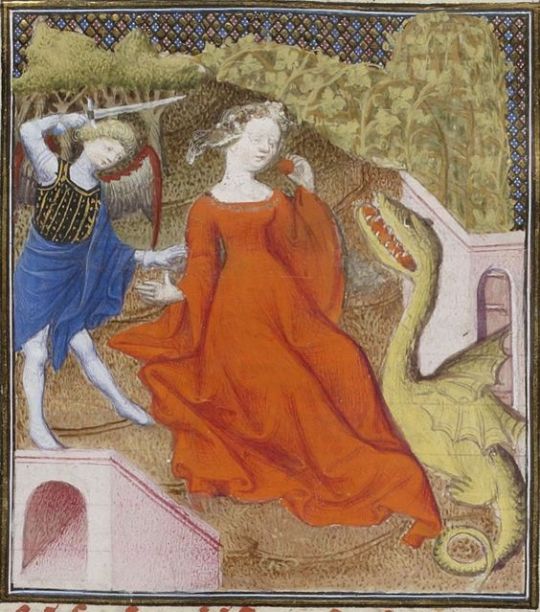
Chemise
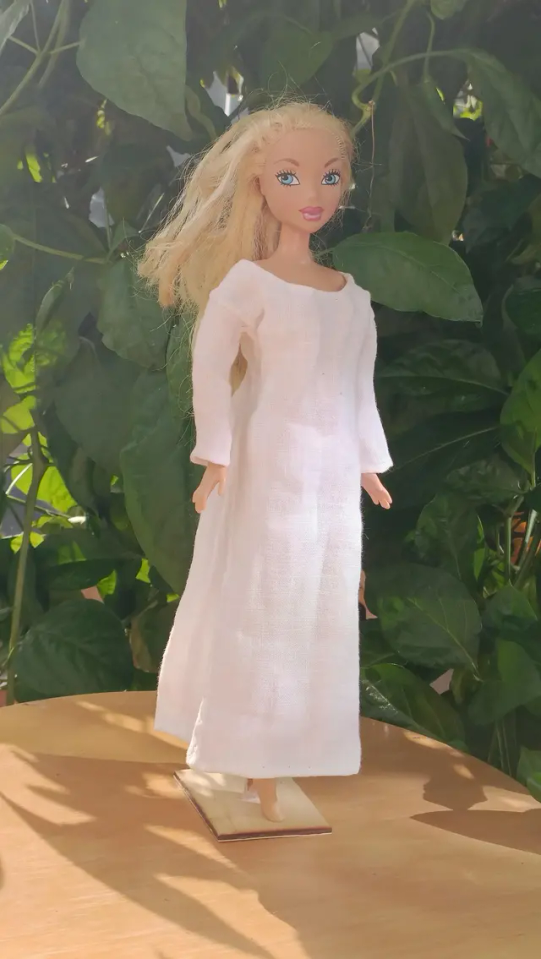
I made a very simple chemise. The construction is based on what we know from extant finds, made out of simple rectangles and triangles, like earlier unlaced kirtles. Based on illustrations, chemise was fairly slim but unfitted enough it didn't need closures. I made it from linen, because it's not very gathered and won't bulk up too much, so I don't need to use my very fine cotton voile.
Cote
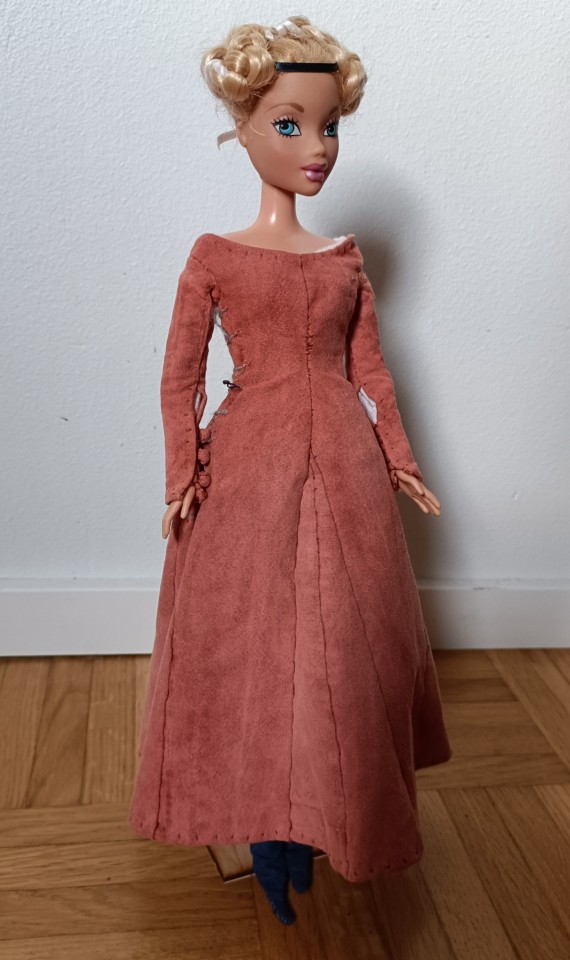
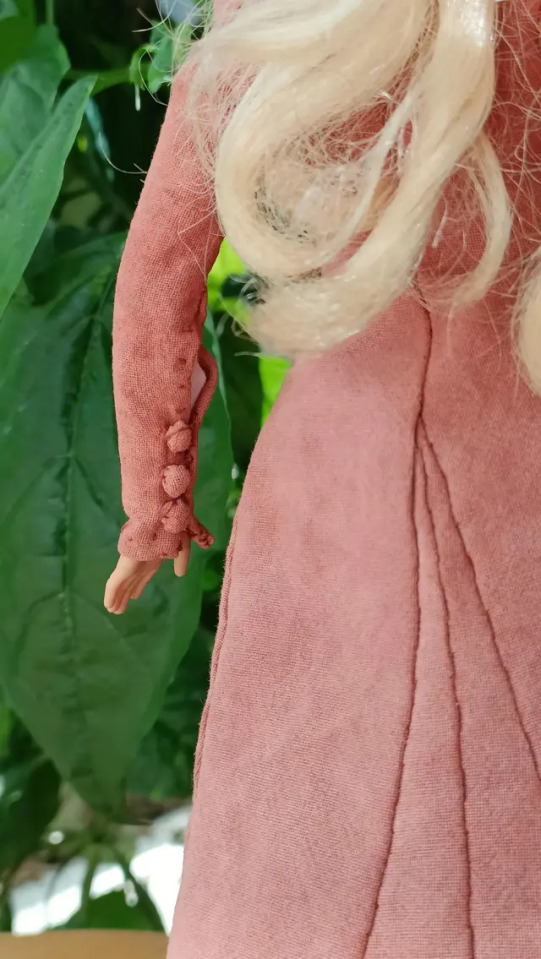
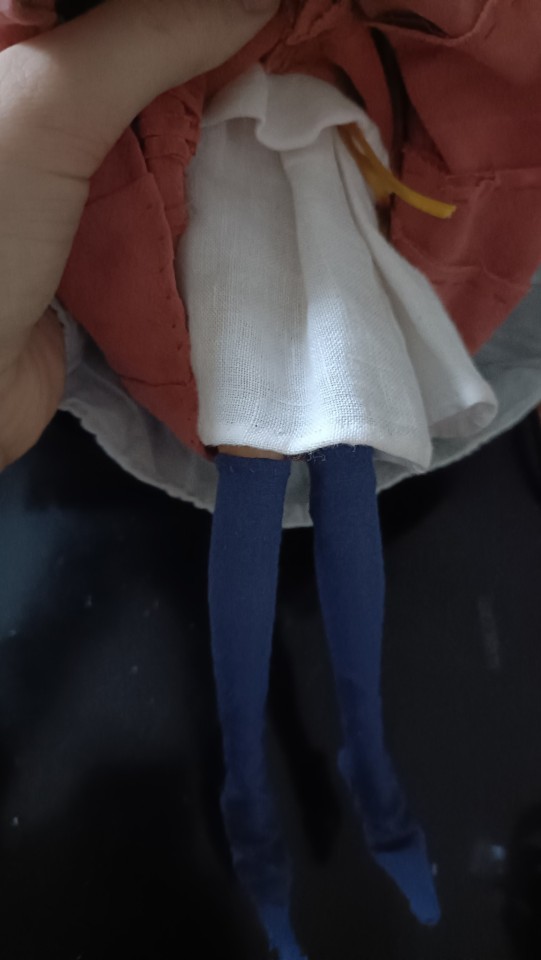
Cote is just the French word for kirtle, so appropriate here. This is the supportive layer cote, which was sort of an undergarment, but was considered fully dressed, if informal on it's own. The sleeves on this underlayer were always long and either fully fitted or gathered at the wrist. Some fitted sleeve styles had a flare at the wrist which covered the hand. The very fitted look was achieved with buttons. The silhouette was smooth and fitted, the waistline was slightly above the natural waist, though that was not as pronounced in France as in Northern Italy. Abdomen was emphasized, round lower stomach was the body ideal. The cut of the dress left plenty of room there. To fill that room I folded the chemise under the abdomen as a sort of padding. This was common to do with any kind of skirts, primarily to raise the hem when working, but why not for this purpose also? The necklines were fairly low and very wide.
I used cotton because I didn't have suitable thin enough wool that wouldn't have created too much bulk on this scale, but the cote should have been made from. The cotton is tightly woven and sells the look of a woven wool in this scale well enough for me. I didn't finish seems or line it to avoid bulk. I did give the lacing a cording to reinforce it and avoid wrinkling. The cotton was originally white, but I dyed it with iron oxide, basically rust, which at least is very much historical.
Hose

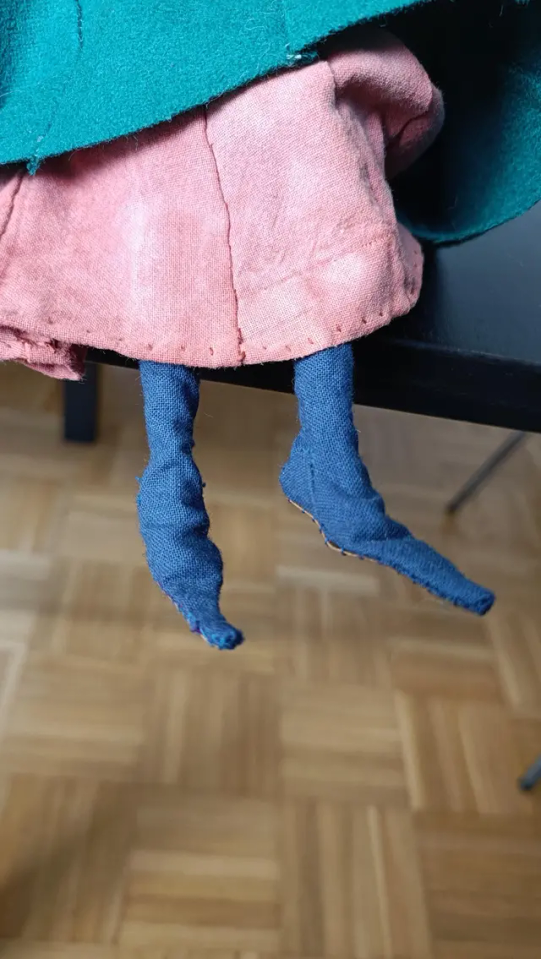
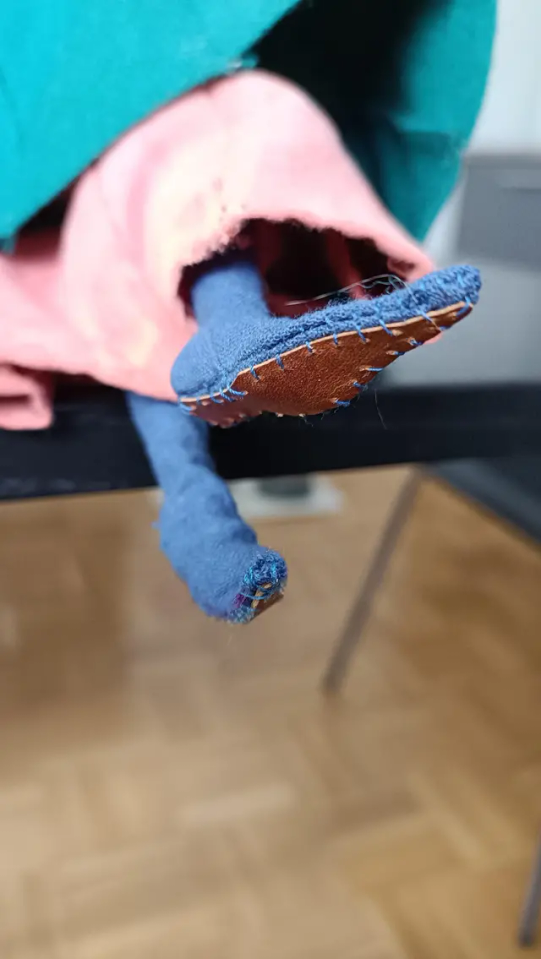
I made the hose from cotton as well for the same reasons as I did the cote. Long pointed style became fashionable around this time, as well as sewing leather soles in the bottoms of the hose instead of using shoes. Though often pattens (wooden flipflops basically) could be used when walking outside to protect the leather soles.
Cornettes or horned hair
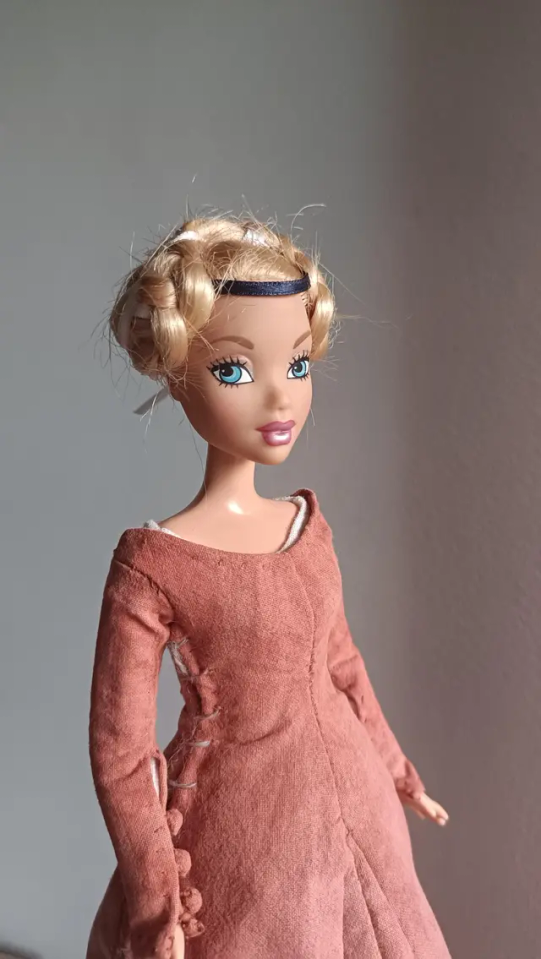
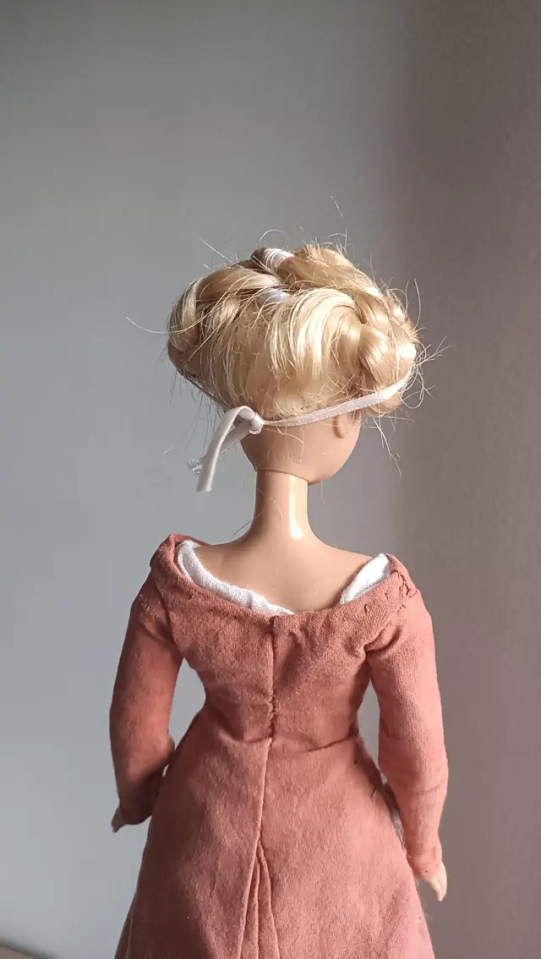
I tied the hair with a tape on cornettes, where the volume of hair was tied on the temples to create a bit of horned appearance, especially when combined with the horned headwear. The sort of fillet which became more of a forehead loop seemed to have been tied into the hair, which I did.
Cotehardie
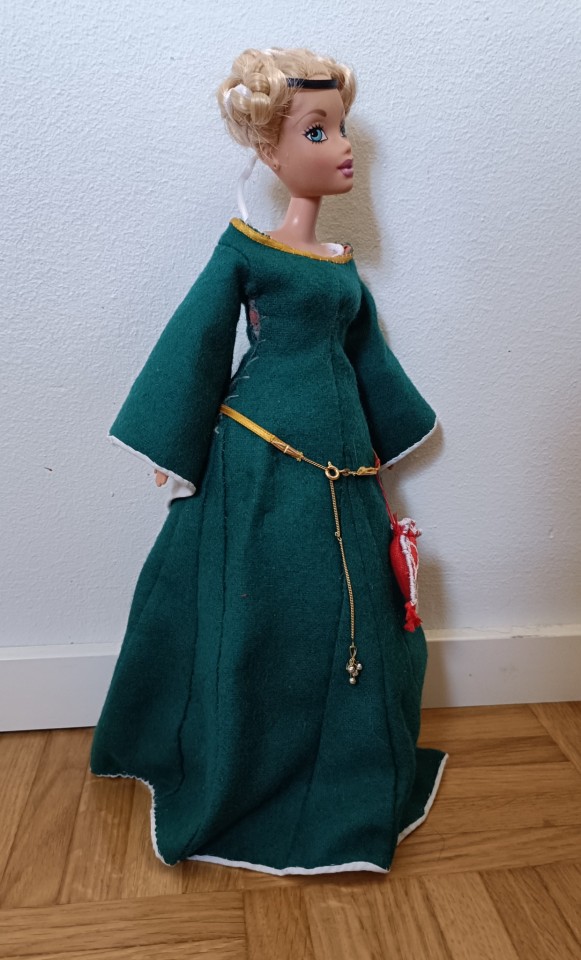





Cotehardie meant literally "bold cote", and in France that was what the formal outer cote was called. It was basically the same as cote, but made from more expensive materials and often had large hanging sleeves. I went with widening triangular sleeves, since they were perhaps the most popular sleeves at the time. I used fine fulled wool (verka) I had enough scraps left from. White fur was popular lining material, but obviously I can't use fur in this scale, I wish I had some light white velvet, it would have been pretty good, but I didn't. I lined the skirt and the sleeves with white cotton to imitate the look without adding too much body or extra bulk. I decorated the neckline with a simple golden trim. I thought about adding a bit of golden embroidery around it too, like seemed to have been popular, but my local crafts store had run out of golden thread so I decided to go with this only.
Accessories
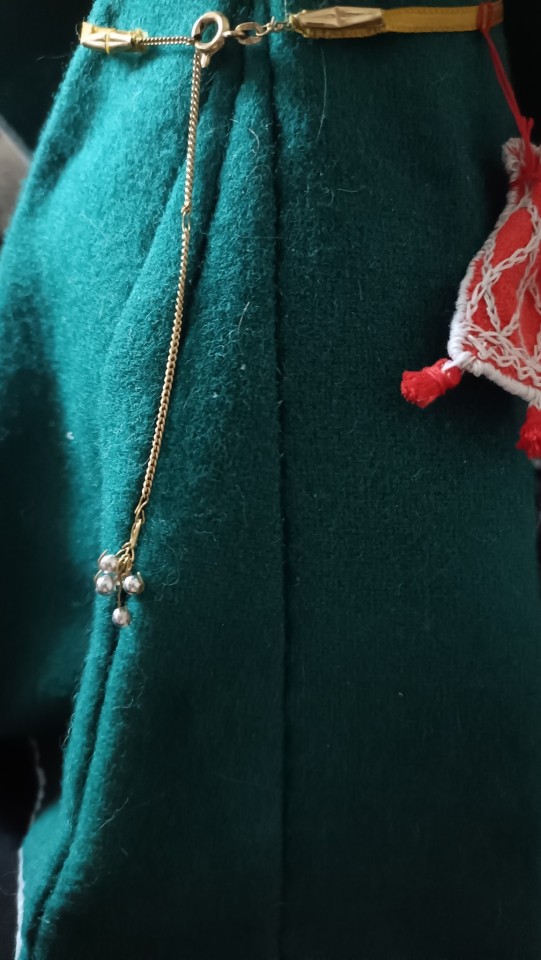



Unlike the belt used with houppelande, which was below bust, the belt used with the kirtle or cotehardie, was very low, under the abdomen to emphasize it. I went for a silk belt look, which I'm imagining is embroidered/woven with golden thread, since embroidery that small would have been too painful. I had an old broken necklace, which I could use for the metallic parts.
With the pouch I went for the tasseled drawstring look, with simple embroidery manageable in this scale. I used linen for it.
Headwear
I made her a chaperon, which likely was where the escoffion got it's beginning, escoffion being the round tube-like headwear worn on top of the head seen in several primary source images above. Early form of escoffion was becoming very popular at the time, though chaperon's were still seen on women too. Chaperon, as seen below both on the left-most woman and the man in the middle was actually just the hood rolled into a circle.
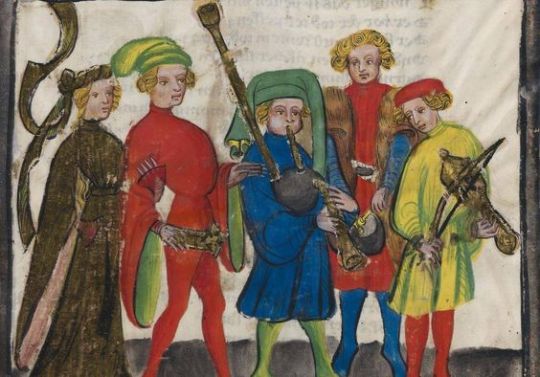
Because the horned look was popular, the escoffion and chaperon were often worn over the wired horned veil, so I first made that. I made it from cotton to make it as light as possible. It was just a square I hemmed. I just used some wire to poke out the horns from her hair and pinned the veil close from the back and onto her hair from the top.
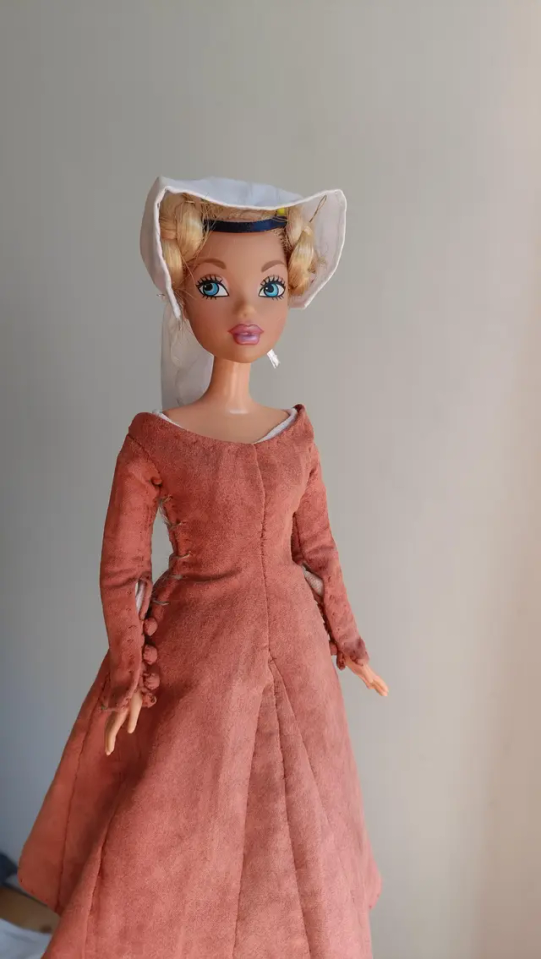

Then I made the open hood. It was just the regular hood which had become very popular during the last century and which had ever longer narrow tip, but it was pinned and worn open, probably because of the hair style and to again create the horned look. I made if from the same cotton I made the hose, even though it too should be from wool. But it was already too bulky as it was.
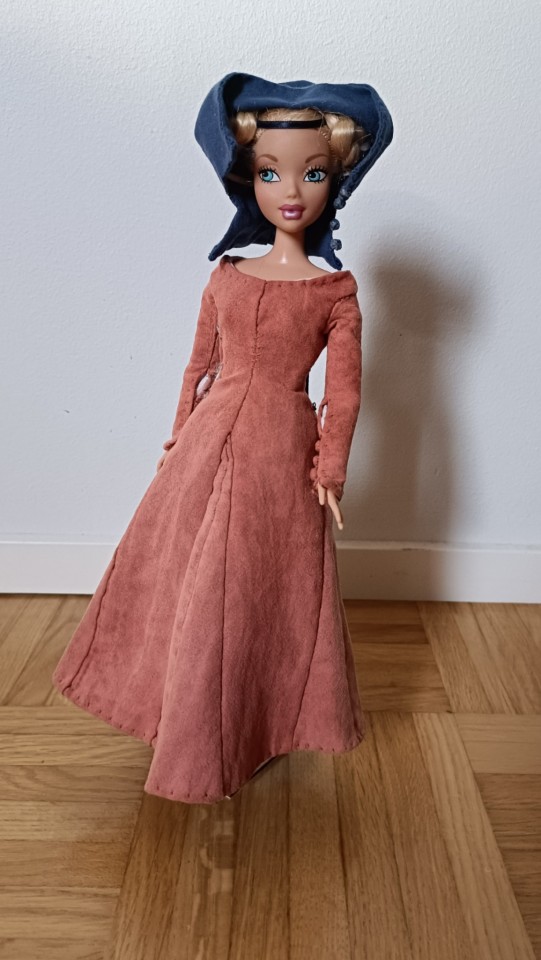
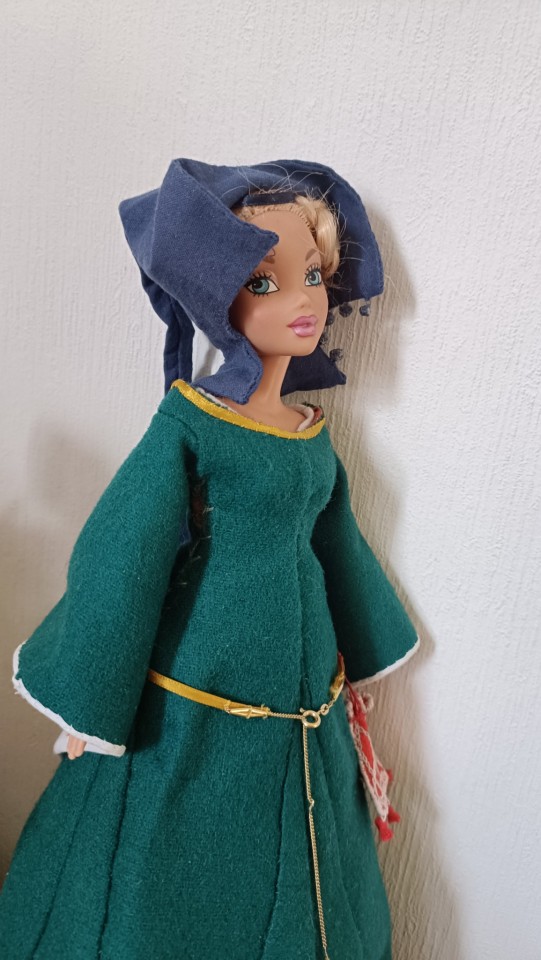
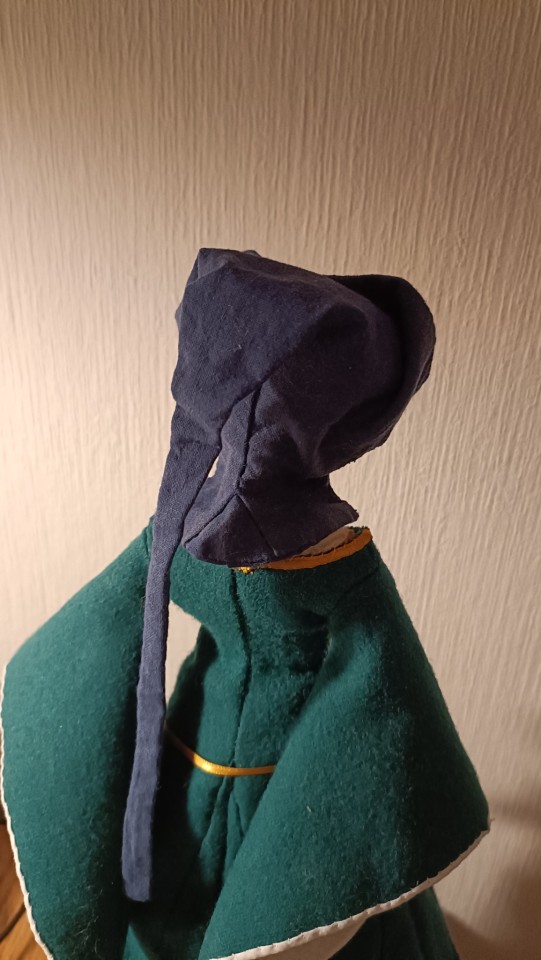
And finally I could make the chaperon. Here's first chaperon without wire or veil under it and then with those. The effect isn't as pronounced as I would have hoped because the hood is too bulky, but there is an effect which is nice.

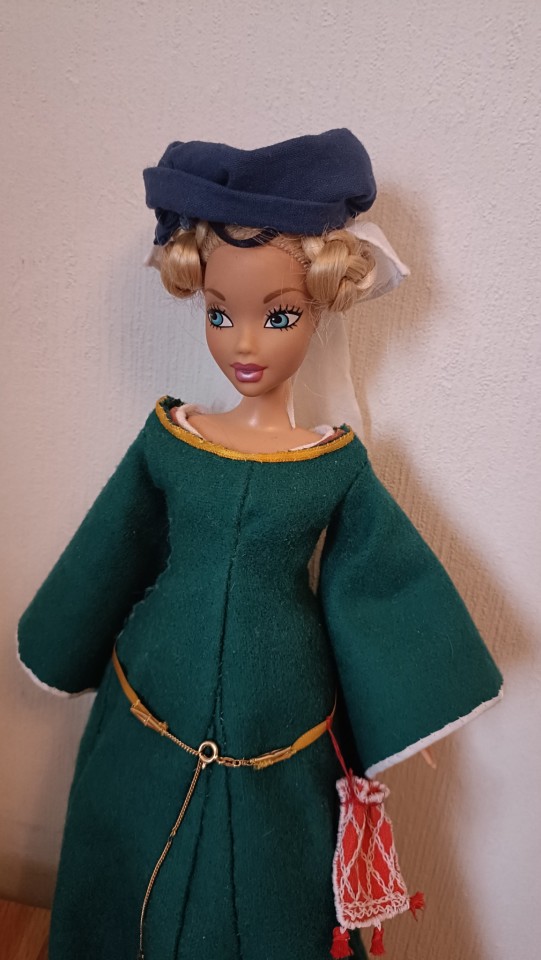
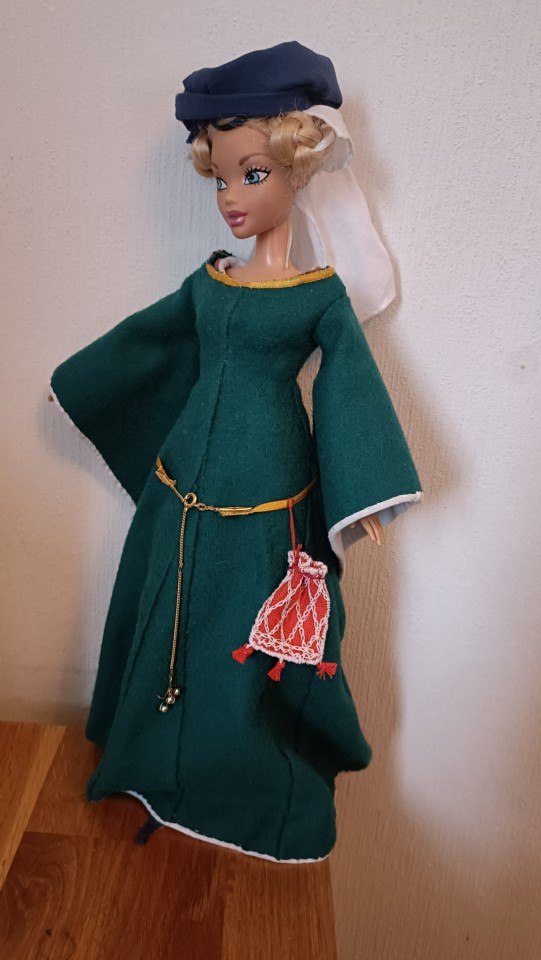
#fashion history#historical fashion#sewing#custom doll#ooak doll#fashion doll#historical sewing#medieval fashion#late medieval fashion#history#historical costuming#my art#doll customization#dollblr#dolls#doll clothes
449 notes
·
View notes
Text

Swords for a sword lover, finally complete ⚔️
#quilting#foundation paper piecing#english paper piecing#modern quilting#textile art#textile arts#fiber art#sewing#quilt#quilts#art#quiltingwitch#swords#cats and quilts#textiles#medieval weapons#lord of the rings#asoiaf#quilters of tumblr
1K notes
·
View notes
Text


head empty just this fresco:

162 notes
·
View notes
Text


wanted to share the medieval hennin that I made for the ren faire this weekend! I crafted it totally from scratch and i'm just really happy with how it turned out :)
(progress pics & steps in the reblog!)
#hennin#headdress#headpiece#medieval fashion#medieval#horned hennin#divided hennin#costume#sewing#fiber art#middle ages#medieval hennin#renaissance faire#renaissance festival#ren faire#historical fashion#theartofmadeline#i need to share this because im wildly proud of it teehee#i want to wear this every day not gonna lie#the outfit was not very 15th century but hey its ren#and i had fun!!!#double horned hennin#cosplay#textile#textile art
282 notes
·
View notes
Text




I'm not sure which is more surprising, the fact I finished this, the fact I photographed this, or the fact it actually fits. Usually I get two out of the three at best.
Anyway, this is my creatively titled "red dragon dress" which I sort of made to celebrate House of the Dragon being back, but also because I like dragons and wanted an excuse to use some of the many scale print fabrics I have hoarded while on my time away from making things.
(I may not be inspired to sew but I am always inspired to waste money on Etsy.)
It was made from a chemically pleated satin, a red jacquard, black brocade, and probably like forty yards of trim. It was fun to play with fabrics and texture again, I must say, even if this project tested my patience at times!
In total it took about 9 days of work from design to drafting to completion, spread over a period of two weeks. Made and modeled by me, as per usual.
I hope you like it, and if you would like to see how I made it, you can see me making it over on the YouTube -- part one [the bodice] and part two [the everything else].
#sewing#costume#costume design#cosplay#sort of#dragon dress#medieval costume#fantasy costume#house of the dragon#well#inspired by house of the dragon#rhaenyra targaryen
334 notes
·
View notes
Text


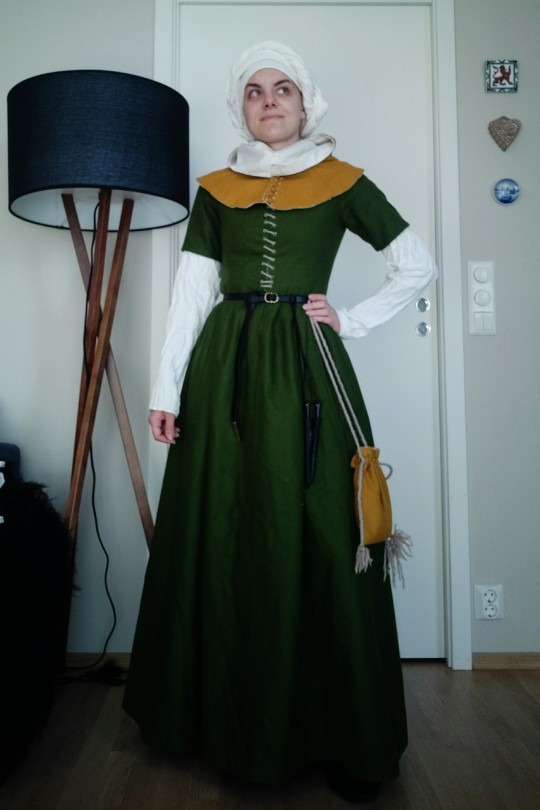


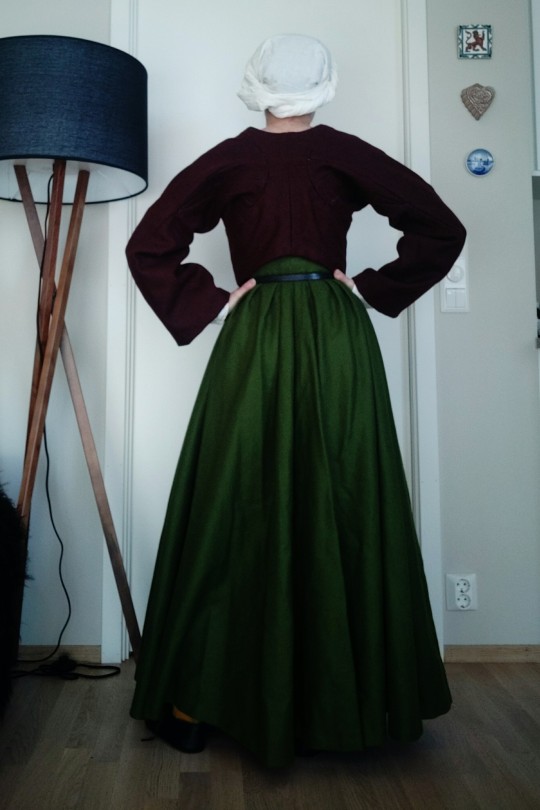

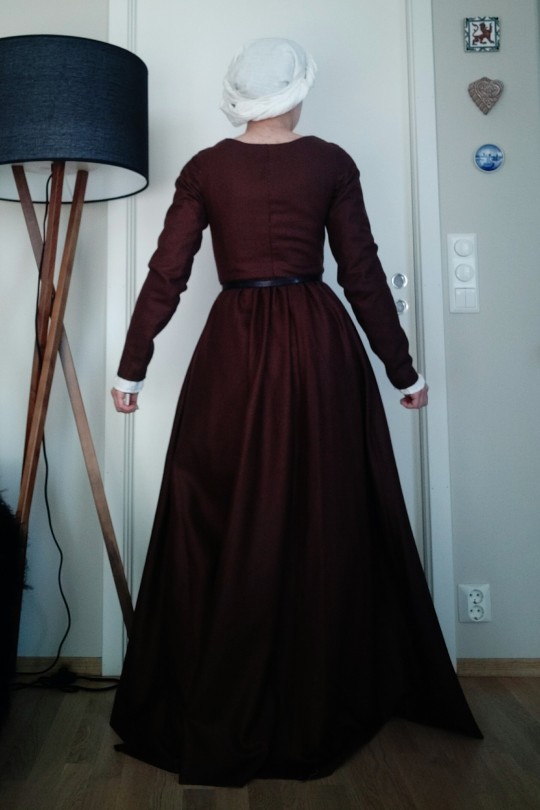

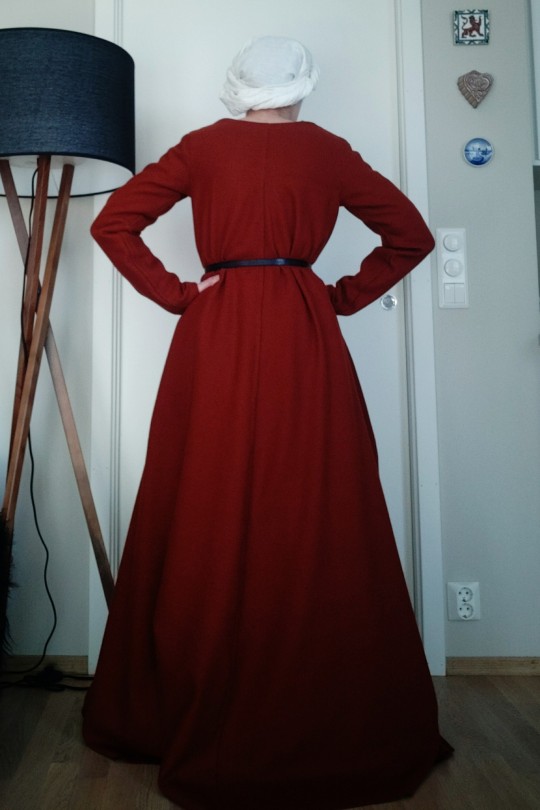
Had to take pictures of my things for an event this summer that I applied for, so here, finally a nice compilation of the things I have made these past two years. I documented all in seperate posts you can find in my pinned post if you like!
#personal#myface#15th century project#sewing adventures#historical reenactment#medieval reenactment#15th century reenactment#late 15th century#medievalcore#medieval clothing#medieval sewing#ignore my face#medieval
215 notes
·
View notes
Text
4 years in the making, a jloak (jean cloak) made from many pairs of 2nd hand jeans and hand-sewn together. Everything is made from denim, the mask made from mod podged scraps.
And the Raven, never flitting, still is sitting, still is sitting
On the pallid bust of Pallas just above my chamber door;
And his eyes have all the seeming of a demon’s that is dreaming,
And the lamp-light o’er him streaming throws his shadow on the floor;
And my soul from out that shadow that lies floating on the floor
Shall be lifted—nevermore!
-Edgar Allen Poe, The Raven







#plague doctor#plaguecore#medieval plague#cryptidcore#plague#bubonic plague#plauge doctor#black plague#medieval#gothic#denim jeans#denim#diycrafts#diy#handmade#sewing#hand sewing
100 notes
·
View notes
Note
I've just started learning to sew my own clothes! I've made one pair of pants that mostly fit and I feel more powerful than god. I've cut out the pieces to sew a dress. I'm going to learn to sew my own jeans. Nothing can stop me.
Sewing your own jeans is next level and I'm frightened of your talent
I'm still figuring out how sewing machines even work. I'm planning on starting small. My future is full of bandanas, easy bags, and loose-fitting tops
#i am hoping to get up to capes and caplets soon though#i want to go as supergirl or robin or something similar for comic con#and sew my own cape for it !!#and then if that goes well - sew a slightly nicer cape/ cloak for the annual medieval fayre#ask
56 notes
·
View notes
Text
*quietly chanting* uneven stitching is historical, uneven stitching is historical, uneven stitching is historical, uneven sti-
782 notes
·
View notes
Text
I googled how much fabric I'd need to make a chemise and kirtle, but now that I'm drafting the dress I see that it calls for a lining, or at least facings to make the linen sturdy enough for eyelets. I already have a pink linen, and a beige embroidered linen. I just dont want to line my sheer dress with the extra pink fabric.


So my next thought was that I don't have enough of the pink, so I decided to just order more now that I know I love it. (so I ordered enough to make a second dress from it.) Then I found another cream colored linen to use for facing because I dont want to use the embroidery for the lining at all; thats just a waste given how pretty it is (and I plan on using the extra yard if beige linen for a matching veil and wimple). So that's how I arrived at a cream linen.

#ciri white dress#cirilla medieval dress#the witcher#medieval costume#historical costuming#fantasy costumes#hand sewing#linen dress#medieval kirtle#sewing project#personal#blog#medieval sewing#diary post
6 notes
·
View notes